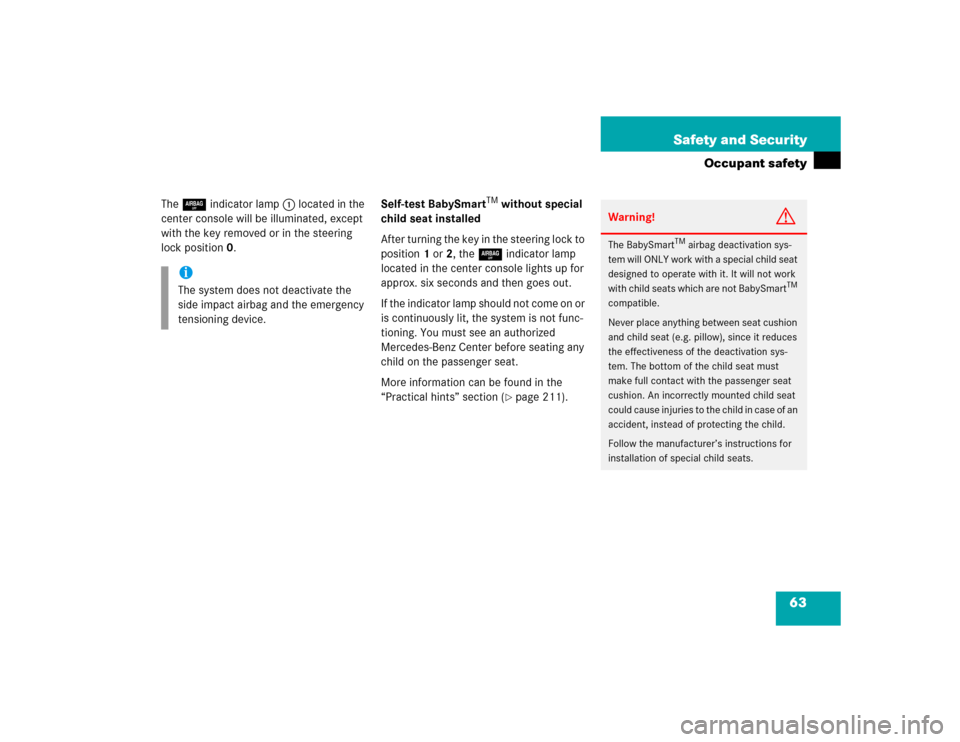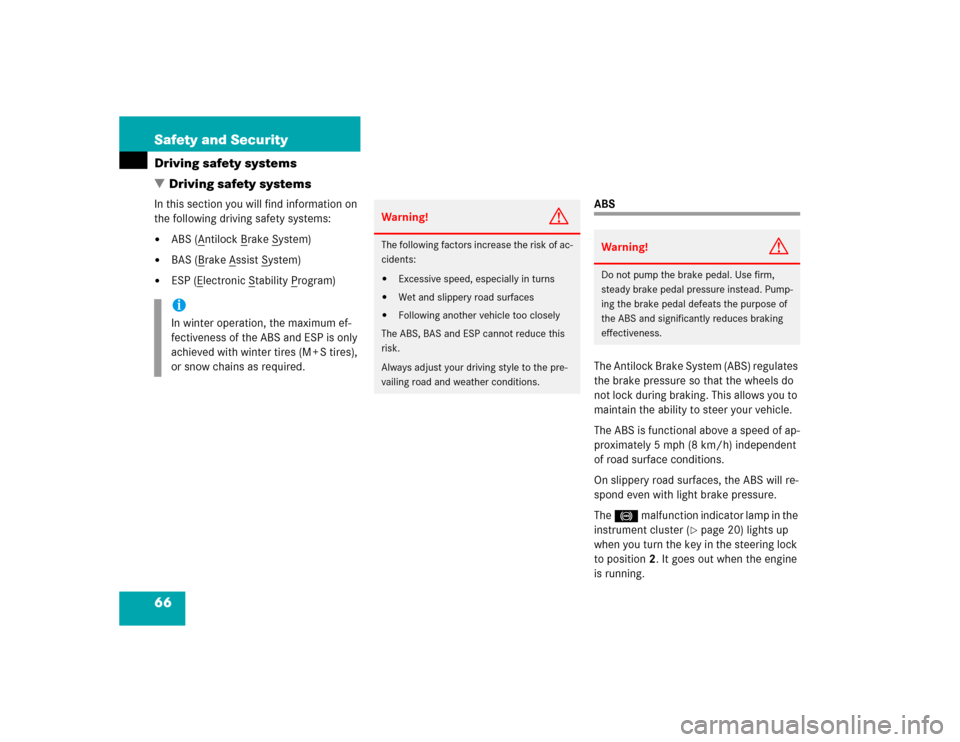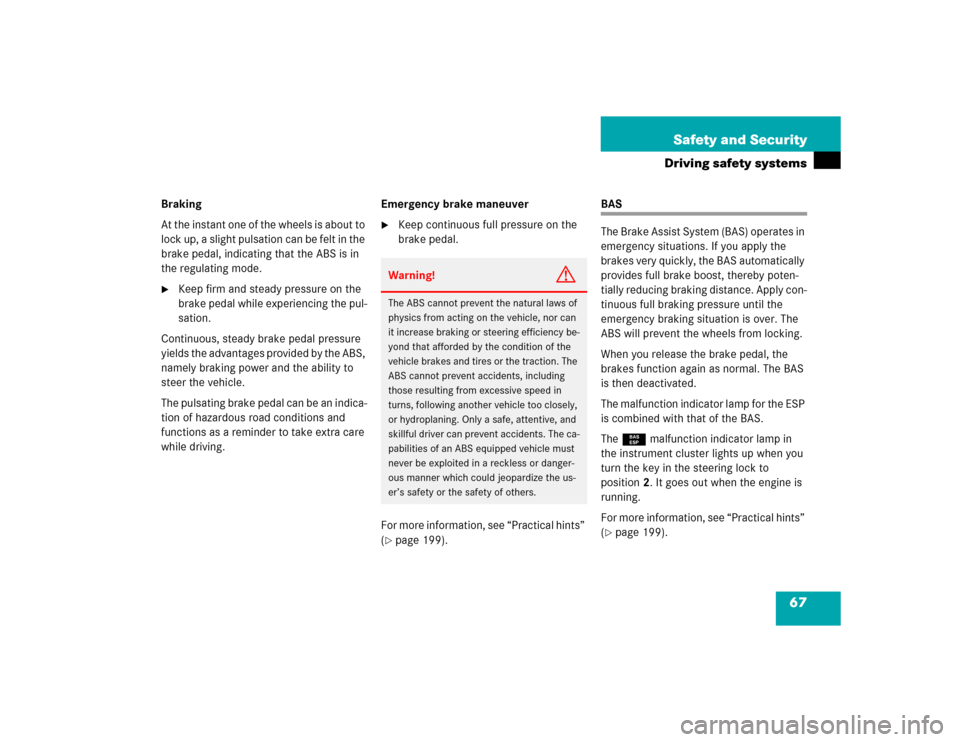Page 36 of 314
36 Getting startedAdjustingThe switch is located on the center
console.
1Driver’s side mirror
2Passenger side mirror
�
Make sure the ignition is switched on.
All the lights in the instrument cluster
light up.
�
Turn switch to position1 for the left
mirror or to position2 for the right
mirror.
�
Toggle switch up, down, left or right
according to the setting desired.
More information can be found in the
“Controls in detail” section (
�page 99).
iAt low ambient temperatures, the exte-
rior mirrors will be heated automatical-
ly.
!If an exterior rear view mirror housing
is forcibly pushed forward or rearward,
reposition it by applying firm pressure
until it snaps into place. The mirror
housing is now properly positioned and
you can adjust the mirror normally.
Page 42 of 314

42 Getting startedDrivingParking brake
1Brake lever
2Release button
�
Pull up slightly on brake lever1 and
press release button2.
Return brake lever1 down to its orig-
inal position.
The indicator lamp; (USA only)
or3 (Canada only) in the instru-
ment cluster goes out.
Driving
�
Move selector lever to positionD orR
(manual transmission: first or reverse
gear)
�
Release the brake pedal.
�
Carefully depress the accelerator
pedal.
Once the vehicle is in motion, the auto-
matic central locking system engages
and the locking knobs drop down.After a cold start, the automatic transmis-
sion shifts at a higher engine revolution.
This allows the catalytic converter to reach
its operating temperature earlier.
Warning!
G
When leaving the vehicle, always remove the
key from the steering lock and lock the vehi-
cle. Do not leave children unattended in the
vehicle, or with access to an unlocked vehi-
cle. Children could release the parking
brake, which could result in an accident
and/or serious injury.
iYou can open a locked door from the
inside. Open door only when conditions
are safe to do so.
!If you hear a warning signal when driv-
ing off, you have forgotten to release
the parking brake.
Release the parking brake.iVehicles with automatic transmission:
Wait for the gear selection process to
complete before setting the vehicle in
motion.
Page 44 of 314
44 Getting startedDrivingHigh beam�
Push the combination switch forward.
The high beam symbolA in the
instrument cluster lights up.
More information can be found in the
“Controls in detail” section (
�page 85).
Windshield wipers
The combination switch is on the left of the
steering column.Combination switch1Switching on windshield wipers
2Single wipe�
Make sure the ignition is switched on.Switching on windshield wipers
�
Turn the combination switch to the de-
sired position depending on the inten-
sity of the rain.
0Windshield wipers off
IIntermittent wiping
IINormal wiper speed
IIIFast wiper speed
iTo signal minor directional changes,
move combination switch to point of
resistance only and release. The turn
signal blinks three times.
iFast wiper speedIII goes to settingII
when the vehicle is standing still.
��
Page 52 of 314

52 Safety and SecurityOccupant safety
�Occupant safetyIn this section you will learn the most im-
portant facts about the restraint systems
of the vehicle.
The restraint systems are�
Seat belts
�
Emergency tensioning device
�
Airbags
�
Child seats
�
Child seat recognition
As independent systems their protective
effects work in conjunction with each oth-
er.The1indicator lamp in the instrument
cluster lights up for about four seconds
when you turn the key in the steering lock
to position1 or2. It goes out when you
start the engine. This shows that the re-
straint systems are operational.
If the lamp does not come on at all or if it
fails to extinguish after approximately four
seconds or if it comes on thereafter, a mal-
function in the system has been detected.
More information can be found in the
“Practical hints” section (
�page 203).
iFor information on infants and children
traveling with you in the vehicle and re-
straint systems for infants and chil-
dren, see “Children in the vehicle”
(�page 60).
Warning!
G
In the event that the SRS malfunction indica-
tor lamp lights up during driving or does not
come on at all, the SRS may not be opera-
tional. For your safety, we strongly recom-
mend that you visit an authorized
Mercedes-Benz Center immediately to have
the system checked; otherwise the SRS may
not be activated when needed in an acci-
dent, which could result in serious or fatal
injury, or it might deploy unexpectedly and
unnecessarily which could also result in inju-
ry.
Improper work on the restraint systems, in-
cluding incorrect installation and removal,
can lead to possible injury through an unin-
tended activation of the SRS.
In addition, through improper work there is
a risk of rendering the SRS inoperative or
causing unintended airbag deployment.
Work on the SRS must therefore only be per-
formed by qualified technicians. Contact
your authorized Mercedes-Benz Center.
Page 63 of 314

63 Safety and Security
Occupant safety
The7indicator lamp 1 located in the
center console will be illuminated, except
with the key removed or in the steering
lock position0.Self-test BabySmart
TM without special
child seat installed
After turning the key in the steering lock to
position1 or2, the7indicator lamp
located in the center console lights up for
approx. six seconds and then goes out.
If the indicator lamp should not come on or
is continuously lit, the system is not func-
tioning. You must see an authorized
Mercedes-Benz Center before seating any
child on the passenger seat.
More information can be found in the
“Practical hints” section (�page 211).
iThe system does not deactivate the
side impact airbag and the emergency
tensioning device.
Warning!
G
The BabySmart
TM airbag deactivation sys-
tem will ONLY work with a special child seat
designed to operate with it. It will not work
with child seats which are not BabySmart
TM
compatible.
Never place anything between seat cushion
and child seat (e.g. pillow), since it reduces
the effectiveness of the deactivation sys-
tem. The bottom of the child seat must
make full contact with the passenger seat
cushion. An incorrectly mounted child seat
could cause injuries to the child in case of an
accident, instead of protecting the child.
Follow the manufacturer’s instructions for
installation of special child seats.
Page 64 of 314
64 Safety and SecurityOccupant safetyWarning!
G
When using a BabySmart
TM compatible
child seat on the passenger seat, the front
passenger airbag will not deploy only if
the7 indicator lamp remains illuminat-
ed.
Please be sure to check the indicator every
time you use the special system child seat.
Should the light go out while the restraint is
installed, please check installation. If the
light remains out, do not use the
BabySmart
TM restraint to transport children
on the passenger seat until the system has
been repaired.
Warning!
G
Do not place powered-on laptops, cell
phones and like electronic devices on the
passenger seat. Signals from such devices
may interfere with the BabySmart
TM system.
Such signal interference may cause
the7 indicator lamp not to come on dur-
ing self-test or be continuously lit, indicating
that the system is not functioning.
Page 66 of 314

66 Safety and SecurityDriving safety systems
�Driving safety systemsIn this section you will find information on
the following driving safety systems:�
ABS (A
ntilock B
rake S
ystem)
�
BAS (B
rake A
ssist S
ystem)
�
ESP (E
lectronic S
tability P
rogram)
ABS
The Antilock Brake System (ABS) regulates
the brake pressure so that the wheels do
not lock during braking. This allows you to
maintain the ability to steer your vehicle.
The ABS is functional above a speed of ap-
proximately 5 mph (8 km/h) independent
of road surface conditions.
On slippery road surfaces, the ABS will re-
spond even with light brake pressure.
The - malfunction indicator lamp in the
instrument cluster (
�page 20) lights up
when you turn the key in the steering lock
to position2. It goes out when the engine
is running.
iIn winter operation, the maximum ef-
fectiveness of the ABS and ESP is only
achieved with winter tires (M + S tires),
or snow chains as required.
Warning!
G
The following factors increase the risk of ac-
cidents:�
Excessive speed, especially in turns
�
Wet and slippery road surfaces
�
Following another vehicle too closely
The ABS, BAS and ESP cannot reduce this
risk.
Always adjust your driving style to the pre-
vailing road and weather conditions.
Warning!
G
Do not pump the brake pedal. Use firm,
steady brake pedal pressure instead. Pump-
ing the brake pedal defeats the purpose of
the ABS and significantly reduces braking
effectiveness.
Page 67 of 314

67 Safety and Security
Driving safety systems
Braking
At the instant one of the wheels is about to
lock up, a slight pulsation can be felt in the
brake pedal, indicating that the ABS is in
the regulating mode.�
Keep firm and steady pressure on the
brake pedal while experiencing the pul-
sation.
Continuous, steady brake pedal pressure
yields the advantages provided by the ABS,
namely braking power and the ability to
steer the vehicle.
The pulsating brake pedal can be an indica-
tion of hazardous road conditions and
functions as a reminder to take extra care
while driving.Emergency brake maneuver
�
Keep continuous full pressure on the
brake pedal.
For more information, see “Practical hints”
(
�page 199).
BAS
The Brake Assist System (BAS) operates in
emergency situations. If you apply the
brakes very quickly, the BAS automatically
provides full brake boost, thereby poten-
tially reducing braking distance. Apply con-
tinuous full braking pressure until the
emergency braking situation is over. The
ABS will prevent the wheels from locking.
When you release the brake pedal, the
brakes function again as normal. The BAS
is then deactivated.
The malfunction indicator lamp for the ESP
is combined with that of the BAS.
The¿ malfunction indicator lamp in
the instrument cluster lights up when you
turn the key in the steering lock to
position2. It goes out when the engine is
running.
For more information, see “Practical hints”
(�page 199).
Warning!
G
The ABS cannot prevent the natural laws of
physics from acting on the vehicle, nor can
it increase braking or steering efficiency be-
yond that afforded by the condition of the
vehicle brakes and tires or the traction. The
ABS cannot prevent accidents, including
those resulting from excessive speed in
turns, following another vehicle too closely,
or hydroplaning. Only a safe, attentive, and
skillful driver can prevent accidents. The ca-
pabilities of an ABS equipped vehicle must
never be exploited in a reckless or danger-
ous manner which could jeopardize the us-
er’s safety or the safety of others.